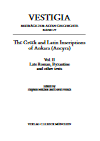Zusammenfassung
The second volume of inscriptions from Ankara, ancient Ancyra, contains editions with commentary and full illustration of nearly two hundred inscriptions from the late Roman and Byzantine periods, and forty texts of Roman imperial date, more than half of which have not been published before, as well as inscriptions for Ancyrans found outside the city dating from the Hellenistic period to late antiquity. The inscriptions are introduced by a new survey of Ankara’s history from the third to the tenth centuries. An important group of inscriptions documents the building of Ancyra’s city walls. A new text suggests that the late Roman fortifications were erected in 267. The city was strategically and politically prominent in the fourth century, when it served as an imperial residence. After the mid-fifth century Ankara’s population was overwhelmingly Christian, and the city had a large monastic population. A monumental inscription states that Ancyra was called the city of the Theotokos. Three lengthy inscriptions present a remarkable collection of biblical and quasi-biblical exempla, depicting the lives of Old Testament figures as role models for Ancyra’s pious inhabitants. Against previous historical reconstructions, it appears that the late Roman city continued to be inhabited after the fall of Ancyra to the Sassanians in 622. The hypothesis that the famous Byzantine citadel dates to the seventh century is rejected in favour of construction in 859, under the emperor Michael III, when Ancyra was hailed as a new Jerusalem. Ancyra enjoyed a revival in the Middle Byzantine period. Inscriptions strengthen the arguments for dating the conversion of the famous imperial temple of Rome and Augustus into a church to the ninth, and the construction of the now destroyed Church of St Clement to the tenth century.
Abstract
The second volume of inscriptions from Ankara, ancient Ancyra, contains editions with commentary and full illustration of nearly two hundred inscriptions from the late Roman and Byzantine periods, and forty texts of Roman imperial date, more than half of which have not been published before, as well as inscriptions for Ancyrans found outside the city dating from the Hellenistic period to late antiquity. The inscriptions are introduced by a new survey of Ankara’s history from the third to the tenth centuries. An important group of inscriptions documents the building of Ancyra’s city walls. A new text suggests that the late Roman fortifications were erected in 267. The city was strategically and politically prominent in the fourth century, when it served as an imperial residence. After the mid-fifth century Ankara’s population was overwhelmingly Christian, and the city had a large monastic population. A monumental inscription states that Ancyra was called the city of the Theotokos. Three lengthy inscriptions present a remarkable collection of biblical and quasi-biblical exempla, depicting the lives of Old Testament figures as role models for Ancyra’s pious inhabitants. Against previous historical reconstructions, it appears that the late Roman city continued to be inhabited after the fall of Ancyra to the Sassanians in 622. The hypothesis that the famous Byzantine citadel dates to the seventh century is rejected in favour of construction in 859, under the emperor Michael III, when Ancyra was hailed as a new Jerusalem. Ancyra enjoyed a revival in the Middle Byzantine period. Inscriptions strengthen the arguments for dating the conversion of the famous imperial temple of Rome and Augustus into a church to the ninth, and the construction of the now destroyed Church of St Clement to the tenth century.
- Kapitel Ausklappen | EinklappenSeiten
- 25–40 2 Bibliography 25–40
- 287–315 5 Ancyrans abroad 287–315
- 323–342 7 Epigraphic indexes 323–342
- 327–328 7.2 Geographical names 327–328
- 330–330 7.4 Professions 330–330
- 331–331 7.7 Funerary 331–331
- 332–332 7.8 Dates and chronology 332–332
- 333–339 7.9 General vocabulary 333–339

